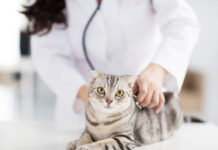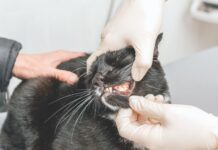Question: My two-year-old female cat has been going into heat two or three times a month since she was about five months old. Is this normal? Im really concerned and need your input.
Answer: Its normal for an unspayed female cat to come into heat at least this often. Domestic cats are seasonally polyestrous, meaning their reproductive (or estrous) cycles occur multiple times during certain parts of the year. The timing of the cycles is largely dependent on the amount of daylight. As the hours of daylight begin to lengthen in temperate parts of the northern hemisphere, the breeding season of cats living outdoors without the influence of artificial lighting typically begins in January or February and extends to September or early October. Cats living indoors with supplemental lighting may cycle all year round.
The stage of the estrous cycle during which a female is fertile and will accept a males amorous advances is called heat or estrus. Estrus may last for just a few days to more than a week, and if the cat is not bred it may recur within a few weeks or even less, only to be repeated over and over again throughout the breeding season. Cats in estrus demonstrate dramatic behavior to say the least.
Loud vocalizations (usually deep, distressed sounding wails), rolling around on the floor, rubbing against objects, incessant seeking of attention, repeated treading of the rear legs and a promiscuous-appearing elevation of the hindquarters with tail held low and to the side are all commonly seen. And if there are any un-neutered males in the neighborhood, you might have found them lurking around your house. These Romeos may urine-mark your porch, too, and tom-cat urine has one of the most unpleasant – and persistent – odors in all creation.
You apparently have the patience of Job to tolerate living this long with a cat in heat. But my question is: Why put everyone through this? It is doing her no good to continuously go through this process – in fact, it may even be harming her – and it cant be contributing to your domestic tranquility. Call your veterinarian and schedule her surgery as soon as possible.
———-
Question: Ive been following the vaccine-associated sarcoma issue for some time, and Im aware of the recommendation to vaccinate cats as far down the legs as possible instead of in between the shoulder blades. Why cant some vaccinations be given under the skin of a cats tail, since if amputation is needed if a sarcoma develops, tail amputation is less traumatic than removing a leg?
Answer: Thank you for the opportunity to revisit the issue of vaccine-associated sarcomas. Longtime CatWatch readers know about this very rare, but very serious, consequence of vaccination. Roughly one to three per 10,000 vaccinated cats develop sarcomas – extremely nasty malignant tumors – at sites on the body where a vaccine was administered. For more information, you can visit the Vaccine-Associated Feline Sarcoma Task Force website at www.avma.org/vafstf, and an excellent site maintained by a tireless cat lover who lost his cat to this condition at http://www.catshots.org/.
In theory, vaccinating in the tail makes sense: A cat has less need for a tail than it does for a limb, so in the unfortunate event of a post-injection cancer, amputation of the tail would likely be less debilitating. But the devil is in the de-tails (sorry about the pun).
Theres progressively less and less subcutaneous space (the area occupied by loose tissue between the skin and the underlying firmer tissues) as one moves from the base of the tail to the tip.
Administering one milliliter – the volume of all injectable vaccines at the moment – would not be possible in the safer areas of the tail farther away from the body. And if one were to give a vaccine in the more voluminous subcutaneous space nearer the body, the problem of amputation is perhaps even worse than if a limb were involved.
Removal of such a malignancy and the required wide margin of tissue around it would compromise important structures within the pelvis (like the rectum, urethra and supporting bones), and retaining necessary bodily functions post-surgery would be extremely difficult, if not impossible.
However, it might be possible to administer a small fraction of a milliliter into the smaller subcutaneous space farther away from the tail base, so one solution might be to reduce the vaccine volume required to induce an immune response (realizing that the expense and time required by a vaccine manufacturer to do so would be considerable). Several groups, including the American Association of Feline Practitioners and the Cornell Feline Health Center are encouraging veterinary vaccine manufacturers to reduce the volume of injectable vaccines and to explore alternate routes of vaccine administration.



